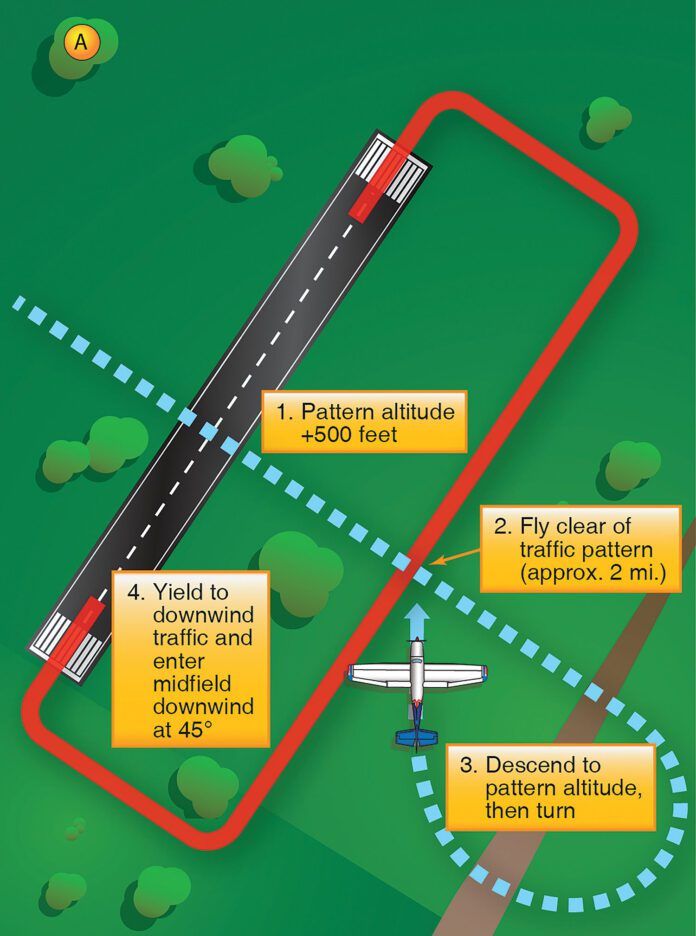Thank you for publishing my recent note about traffic pattern entry in your November issue, which originated with October’s article “Parallel Runway Traps.” You gave me an answer, but sorry to say, I’m not satisfied with it.
While I think the overflight followed by a right 270-degree turn to enter left traffic is an excellent and safe method to enter the pattern, I think your answer that the right turn is not performed in the pattern misses the mark.
The regulations, FARs 91.126 and 91.127, say nothing about the pattern. They simply specify that when operating in the vicinity of an airport in Class G or E airspace, all turns must be made to the left unless otherwise specified.
So, one question is what constitutes the “vicinity.” There is no FAA definition I can find to clarify that question. A TAF with VC in the text means between five and 10 miles (with the TAF itself covering the immediate five miles). But it would seem to me that a turn within two miles of the airport as suggested is clearly done in the vicinity of the airport.
Again, I personally think that the overflight/270 right turn to downwind is an excellent way to enter a pattern. I just wish the FAA would address the fact that it clearly diverges from FARs 91.126 and 91.127. And discussing the regulation in association with the diagram in the Airplane Flying Handbook would be an excellent place to do so.
I wonder if any pilots have been issued violations by overzealous FSDO inspectors who witness such a pattern entry. Do you know?
—Jerrold Seckler, via email
More…
In reference to your response to Mr Seckler’s letter (a question about the article “Parallel Runway Traps“): It’s not AC-90-C; it’s AC-90-66C. Additionally, it’s not merely “clear of the downwind leg itself” but “well clear” and specifically, the suggested distance has two caveats—sufficient to see and avoid, and safely enter traffic and on the pattern picture you posted (taken from page A-5 of the AC) labeled point 2 “Fly clear of traffic pattern (approx. 2 mi).”
I’m based at the Auburn (Wash.) Municipal Airport (S50), which has a downwind leg situated one nm southeast of the Seattle Class B surface wall. Given our location, we run a non-standard pattern for left traffic to Runway 34, which has a one-mile, 45-degree entry leading not to midfield but to the abeam (descent flow) point. Because of this, I strive for routes with gentle turns to the 45 and avoid maneuvering. However, a supermajority of pilots who choose to perform field crossovers to maneuver for the 45 do so by breaking into their turn perhaps only half a mile past the downwind. This creates potential midair maneuvering conflicts with little room and time to see and avoid in an area where successful evasive maneuvers will likely result in one of the two deviating into the Class B surface area.
—Dan Anderson, Des Moines, Wash.
…And More
In the October 2023 issue, page 6, the author discusses and shows a diagram of how to enter a pattern from the upwind side. That is not the only method recommended by the FAA in AC 90-66C, Appendix A. A pilot has to determine which method is safer based on an assessment of how busy the pattern is.
—Herbert Rosenthal, Bethesda, Md.
You all raise good points. We’re not aware of any related violations, but we also don’t monitor for them.
One suggestion would be to provide formal feedback to the agency. The fine print in the current AFH includes an email address for comments: [email protected]. Please keep us posted.
Send your thoughts, comments or questions to [email protected]




